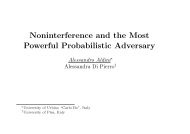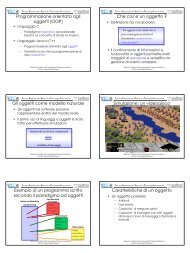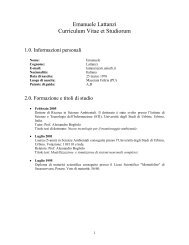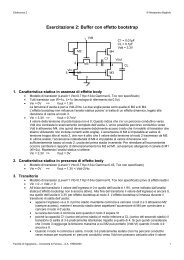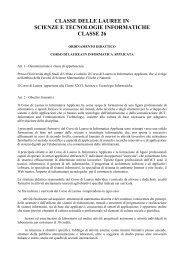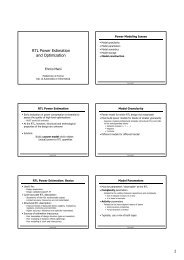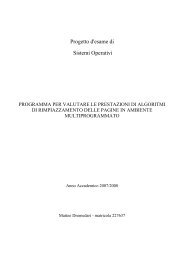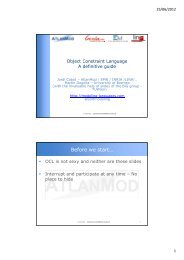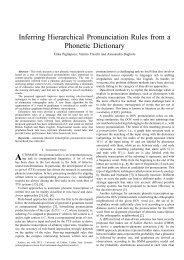Real-Time Operating Systems
Real-Time Operating Systems
Real-Time Operating Systems
Create successful ePaper yourself
Turn your PDF publications into a flip-book with our unique Google optimized e-Paper software.
<strong>Real</strong>-<strong>Time</strong><br />
<strong>Operating</strong> <strong>Systems</strong><br />
1<br />
Summary<br />
¿ Introduction<br />
¿ Basic concepts<br />
¿ RT Scheduling<br />
¿ Aperiodic task scheduling<br />
¿ Periodic task scheduling<br />
¿ Embedded RTOS<br />
¿ Source:<br />
G.Buttazzo, “Hard <strong>Real</strong>-<strong>Time</strong> Computing <strong>Systems</strong> –<br />
Predictable Scheduling Algorithms and Applications“,<br />
Kluwer Academic Publishers.<br />
2<br />
1
¿ <strong>Real</strong>-time system:<br />
Introduction<br />
“A real-time system is a computer system in which the<br />
correctness of the system behavior depends not only on<br />
the logical results of the computation, but also on the<br />
physical instant at which these results are produced”<br />
“A real-time system is a system that is required to<br />
react to stimuli from the environment (including the<br />
passage of physical time) within time intervals<br />
dictated by the environment”<br />
3<br />
Introduction (2)<br />
¿ Examples of real-time systems:<br />
¿ plant control<br />
¿ control of production processes / industrial automation<br />
¿ railway switching systems<br />
¿ automotive applications<br />
¿ flight control systems<br />
¿ environmental acquisition and monitoring<br />
¿ telecommunication systems<br />
¿ robotics<br />
¿ military systems<br />
¿ space missions<br />
¿ household appliances<br />
¿ virtual / augmented reality<br />
4<br />
2
¿ <strong>Real</strong>-time<br />
Introduction (3)<br />
¿ <strong>Time</strong>: main difference to other classes of computation<br />
¿ <strong>Real</strong>: reaction to external events must occur during<br />
their evolution.<br />
¿ System time (internal time) has to be measured<br />
with same time scale as controlled environment<br />
(external time)<br />
¿ <strong>Real</strong> time does not mean fast but predictable<br />
¿ Concept of deadline:<br />
¿ <strong>Time</strong> after which a computation is not just late,<br />
but also wrong<br />
5<br />
¿ Hard RT task:<br />
Hard vs. real time<br />
¿ if missing its deadline may cause catastrophic<br />
consequences on the environment under control<br />
¿ Soft RT task:<br />
¿ if meeting its deadline is desirable (e.g. for performance<br />
reasons) but missing does not cause serious damage<br />
¿ RTOS that is able to handle hard RT tasks is called<br />
hard real-time OS<br />
6<br />
3
Hard vs. real time (2)<br />
¿ Typical hard real time activities<br />
¿ sensory data acquisition<br />
¿ detection of critical conditions<br />
¿ actuator servoing<br />
¿ low-level control of critical system components<br />
¿ Areas of application:<br />
¿ Automotive:<br />
• power-train control, air-bag control,<br />
steer by wire, brake by wire<br />
¿ Aircraft:<br />
• engine control, aerodynamic control<br />
7<br />
Hard vs. real time (3)<br />
¿ Typical soft real time activities:<br />
¿ command interpreter of user interface<br />
¿ keyboard handling<br />
¿ displaying messages on screen<br />
¿ transmitting streaming data<br />
¿ Areas of application:<br />
¿ Communication systems:<br />
• voice over IP, cellular telephony<br />
• user interaction<br />
• comfort electronics (body electronics in cars)<br />
8<br />
4
RTOS<br />
9<br />
<strong>Real</strong>-time <strong>Operating</strong> <strong>Systems</strong><br />
¿ RT systems require specific support from OS<br />
¿ Conventional OS kernels are inadequate w.r.t.<br />
RT requirements:<br />
¿ Multitasking/scheduling<br />
• provided through system calls<br />
• does not take time into account (introduce unbounded delays)<br />
¿ Interrupt management<br />
• achieved by setting interrupt priority > than process priority<br />
• increase system reactivity but may cause unbounded delays on<br />
process execution even due to unimportant interrupts<br />
¿ Basic IPC and synchronization primitives<br />
• may cause priority inversion (high priority task blocked by a low<br />
priority task)<br />
¿ No concept of RT clock<br />
10<br />
5
<strong>Real</strong>-time <strong>Operating</strong> <strong>Systems</strong> (2)<br />
¿ Desirable features of a RTOS:<br />
¿ <strong>Time</strong>liness<br />
• OS has to provide mechanisms for:<br />
• time management<br />
• handling tasks with explicit time constraints<br />
¿ Predictability<br />
¿ Fault tolerance<br />
¿ Design for peak load<br />
¿ Maintainability<br />
11<br />
RTOS evaluation metrics<br />
¿ Interrupt latency (T il<br />
):<br />
¿ the time from the start of the physical<br />
interrupt to the execution of the first<br />
instruction of the interrupt service routine<br />
¿ Scheduling latency<br />
(interrupt dispatch latency) (T sl<br />
):<br />
¿ the time from the execution of the last<br />
instruction of the interrupt handler to the<br />
first instruction of the task made ready by<br />
that interrupt<br />
¿ Context-switch time (T cs<br />
):<br />
¿ the time from the execution of the last<br />
instruction of one user-level process to<br />
the first instruction of the next user-level<br />
process<br />
¿ Maximum system call time:<br />
¿ should be predictable & independent of<br />
the # of objects in the system<br />
12<br />
6
<strong>Real</strong>-time <strong>Operating</strong> <strong>Systems</strong> (3)<br />
¿ <strong>Time</strong>liness<br />
¿ Achieved through proper scheduling algorithms<br />
• Core of an RTOS!<br />
¿ Predictability<br />
¿ Affected by several issues:<br />
• I/O & interrupts<br />
• Synchronization & IPC<br />
• Architecture<br />
• Memory management<br />
• Applications<br />
• Scheduling!<br />
13<br />
Achieving predictability: interrupts<br />
¿ One of the biggest problem for predictability<br />
¿ Typical device driver:<br />
<br />
<br />
<br />
¿ In most OS:<br />
• interrupts served with respect to fixed priority scheme<br />
• interrupts have higher priorities than processes<br />
Æ problem in real-time systems:<br />
• processes may be of higher importance than I/0 operation!<br />
14<br />
7
Achieving predictability: interrupts<br />
¿ First solution: Disable all interrupts but timer<br />
interrupts<br />
¿ all peripheral devices have to be handled by<br />
application tasks<br />
¿ data transfer by polling<br />
¿ great flexibility, data transfers can be estimated<br />
precisely<br />
¿ no change of kernel needed when adding devices<br />
¿ Problems:<br />
¿ degradation of processor performance (busy wait)<br />
¿ no encapsulation of low level details<br />
15<br />
Achieving predictability: interrupts<br />
¿ Second solution: Disable all interrupts but timer<br />
interrupts, plus handle devices by special, timeractivated<br />
kernel routines<br />
¿ unbounded delays due to interrupt driver eliminated<br />
¿ periodic device routines can be estimated in advance<br />
¿ hardware details encapsulated in dedicated routines<br />
¿ Problems<br />
¿ degradation of processor performance (still busy waiting<br />
- within I/0 routines)<br />
¿ more inter-process communication than first solution<br />
¿ kernel has to be modified when adding devices<br />
16<br />
8
Achieving predictability: interrupts<br />
¿ Third solution: Enable external interrupts and<br />
reduce the drivers to the least possible size<br />
¿ driver only activates proper task to take care of device<br />
¿ The task executes under direct control of OS, just like<br />
any other task<br />
¿ control tasks than have higher priority than device task<br />
17<br />
Achieving predictability: interrupts<br />
¿ Advantages<br />
¿ busy wait eliminated<br />
¿ unbounded delays due to unexpected device handling<br />
dramatically reduced (not eliminated !)<br />
¿ remaining unbounded overhead may be estimated<br />
relatively precisely<br />
¿ State of the art !<br />
18<br />
9
Achieving predictability:<br />
system calls & IPC<br />
¿ All kernel calls have to be characterized by<br />
bounded execution time<br />
¿ each kernel primitive should be preemptable<br />
¿ Usual semaphore mechanism not suited for real<br />
time applications:<br />
¿ Priority inversion problem (high priority task is blocked<br />
by low priority task)<br />
¿ Solution: use special mechanisms:<br />
• Basic Priority Inheritance protocol<br />
• Priority ceiling<br />
19<br />
Priority inversion (1)<br />
¿ Typical characterization of priority inversion:<br />
¿ A medium-priority task preempts a lower-priority task<br />
that is using a shared resource on which a higherpriority<br />
task is pending.<br />
¿ If the higher-priority task is otherwise ready to run, but<br />
a medium-priority task is currently running instead, a<br />
priority inversion is said to occur.<br />
¿ Example:<br />
H<br />
M<br />
L<br />
20<br />
10
Priority inversion (2)<br />
¿ Basic priority inheritance protocol:<br />
1. A job J uses its assigned priority, unless it is in its CS<br />
and blocks higher priority jobs<br />
In which case, J inherits P H<br />
, the highest priority of the<br />
jobs blocked by J<br />
When J exits the CS, it resumes the priority it had at<br />
the point of entry into the CS<br />
2. Priority inheritance is transitive<br />
¿ Advantage:<br />
¿ Transparent to scheduler<br />
¿ Disadvantage:<br />
¿ Deadlock possible<br />
21<br />
Priority inversion (3)<br />
¿ Priority ceiling protocol<br />
1. A priority ceiling is assigned to each resource, which is<br />
equal to the highest priority task that may use the<br />
resource<br />
2. The scheduler transfers that priority to any task that<br />
accesses the resource<br />
3. Job J is allowed to start a new CS only if its priority is<br />
higher than all priority ceilings of all the semaphores<br />
locked by jobs other than J<br />
4. On completion, J’s priority switches to its normal value<br />
¿ Advantage:<br />
¿ tasks can share resources simply by changing their<br />
priorities, thus eliminating the need for semaphores<br />
22<br />
11
¿ Inheritance<br />
Priority inheritance<br />
and priority ceiling<br />
¿ Ceiling<br />
23<br />
Achieving predictability:<br />
architecture<br />
¿ Obvious source for unpredictability:<br />
¿ Memory accesses not deterministic<br />
¿ Example:<br />
• hit ratio = 90 %, T cache = 10ns, T mem = 50ns<br />
• => 10 % of accesses have access time 18% larger than<br />
cacheless case<br />
¿ Solutions:<br />
¿ systems without cache (or disabled)<br />
¿ precise estimation of caching behaviour<br />
• <strong>Systems</strong> with application-specific buffers<br />
24<br />
12
Achieving predictability:<br />
memory management<br />
¿ Avoid non-deterministic delays<br />
¿ No conventional demand paging (page fault handling!)<br />
• May use selecitve page locking to increase determinism<br />
¿ Typically used:<br />
¿ Memory segmentation<br />
¿ Static partitioning<br />
¿ Problems:<br />
¿ flexibility reduced<br />
¿ careful balancing required<br />
25<br />
Achieving predictability:<br />
Applications<br />
¿ Current programming languages not expressive<br />
enough to prescribe precise timing<br />
¿ Need of specific RT languages<br />
¿ Desirable features:<br />
¿ no dynamic data structures<br />
¿ no recursion<br />
¿ only time-bound loops<br />
26<br />
13
¿ Proprietary:<br />
¿ VxWorks by WindRiver<br />
¿ LynxOS by Lynx<br />
What RTOS?<br />
¿ Free/Academical/Open-source:<br />
¿<br />
¿ QNX<br />
¿ RTLinux<br />
¿ Spring<br />
¿ RTX<br />
¿ …<br />
27<br />
<strong>Real</strong>-time<br />
Process Management<br />
& Scheduling<br />
28<br />
14
Processes<br />
¿ Called tasks in the RT community<br />
¿ Basic concepts:<br />
¿ Task scheduling<br />
¿ Scheduling problems & anomalies<br />
29<br />
Scheduling: preliminaries<br />
¿ Key fact:<br />
Any RT scheduling policy must be preemptive:<br />
¿ Tasks performing exception handling may need to<br />
preempt running tasks to ensure timely reaction<br />
¿ Tasks may have different levels of criticalness. This can<br />
be mapped to a preemption scheme<br />
¿ More efficient schedules can be produced with<br />
preemption<br />
30<br />
15
Scheduling: definition<br />
¿ Given a set of tasks J = {J 1 , ...J n } a schedule is<br />
an assignment of tasks to the processor so that<br />
each task is executed until completion.<br />
¿ Formally:<br />
¿ A schedule is a function σ : R+ → N such that:<br />
¿ ∀t ∈ R +, ∃ t 1 , t 2 ∈ R +, ∀t∈ [t 1 ,t 2 ) σ(t) = σ(t‘)<br />
¿ In practice, σ is an integer step function<br />
σ(t) = k means task J k is executing at time t,<br />
σ(t) = 0 means CPU is idle<br />
¿ Each interval [t i ,t i+1 ) with σ(t) constant for t ∈ [t i ,t i+1 ) is<br />
called a time slice<br />
31<br />
Scheduling: example<br />
¿ A schedule is called feasible if all tasks can be<br />
completed according to a set of specified<br />
constraints<br />
¿ A set of tasks is called schedulable if there exist at<br />
least one algorithm that can produce a feasible<br />
schedule<br />
¿ Example:<br />
32<br />
16
Scheduling constraints<br />
¿ The following types of constraints are considered:<br />
¿ Timing constraints<br />
• meet your deadline<br />
¿ Precedence constraints<br />
• respect prerequisites<br />
¿ Resource constraints<br />
• access only available resources<br />
33<br />
Timing constraints<br />
¿ <strong>Real</strong>-time systems are characterized mostly by<br />
timing constraints<br />
¿ Typical timing constraint: deadline<br />
¿ Deadline missing separates two classes of RT<br />
systems:<br />
¿ Hard : missing of deadline can cause catastrophic<br />
consequences<br />
¿ Soft : missing of deadline decreases performance of<br />
system<br />
34<br />
17
¿ Arrival time a i :<br />
Task characterization<br />
¿ the time J i becomes ready for execution<br />
¿ Also called release time r i<br />
¿ Computation time C i :<br />
¿ time necessary for execution without interruption<br />
¿ Deadline d i :<br />
¿ time before which task has to complete its execution<br />
¿ Start time S i :<br />
¿ time at which J i start its execution<br />
¿ Finishing time f i :<br />
¿ time at which J i finishes its execution<br />
J i<br />
S i<br />
C i<br />
f i<br />
d i<br />
a i<br />
36<br />
t<br />
35<br />
¿ Lateness L i :<br />
Task characterization (2)<br />
¿ L i = f i - d i<br />
¿ delay of task completion with respect to d i<br />
¿ Tardiness E i:<br />
¿ E i = max (0, L i )<br />
¿ time a task stays active after its deadline<br />
¿ Laxity or slack time X i :<br />
¿ X i = d i - a i<br />
¿ maximum time a task can be delayed on first activation<br />
to complete before its deadline<br />
18
Periodic and aperiodic tasks<br />
¿ Periodic task t i consists of infinite sequence of<br />
identical activities, called instances or job<br />
¿ regularly activated at a constant rate<br />
¿ Activation of first instance of t is called j i<br />
¿ T i = period of the task<br />
¿ Each task t i can be characterized by C i , T i, , D i<br />
• C i , T i, , D i constant for each instance<br />
• In most cases: C i =D i<br />
¿ Aperiodic task J i consists of infinite sequence of<br />
identical activities (instances)<br />
¿ Their activations are not regular<br />
37<br />
Periodic and aperiodic tasks:<br />
example<br />
38<br />
19
Precedence constraints<br />
¿ Task have often to respect some precedence<br />
relations<br />
¿ Described by a precedence graph G:<br />
• Nodes N(G): tasks<br />
• Edges E(G): precedence relations<br />
¿ G induces partial order on task set.<br />
39<br />
Precedence constraints: example<br />
¿ System for recognizing object on a<br />
conveyer belt through two cameras<br />
¿ Tasks<br />
¿ For each camera:<br />
• image acquisition acq1 and acq2<br />
• low level image processing edge1 and<br />
edge2<br />
¿ Task shape to extract two-dimensional<br />
features from object contoures.<br />
¿ Task disp to compute pixel disparities<br />
from the two images:<br />
¿ Task that calculates object height from<br />
results of disp: H<br />
¿ Task that performs final recognition<br />
based on H and shape: rec<br />
40<br />
20
<strong>Real</strong>-time scheduling<br />
41<br />
¿ Given:<br />
Scheduling: formulation<br />
¿ a set of n tasks J = {J 1 , ..., J n }<br />
¿ a set of m processor P = {P 1 , ..., P m }<br />
¿ a set of s resources R = {R 1 , ..., R s }<br />
¿ Precedences specified using a precedence graph<br />
¿ Timing constraints may be associated to each task.<br />
¿ Scheduling means to assign processors from P and<br />
resources from R to tasks from J in order to<br />
complete all tasks under the imposed constraints.<br />
=NP-complete!<br />
42<br />
21
Scheduling: classification<br />
¿ Preemptive/non-preemptive<br />
¿ Static<br />
¿ scheduling decisions based on fixed parameters<br />
¿ Dynamic<br />
¿ scheduling decisions based on parameters that change<br />
during system evolution<br />
¿ Off-line<br />
¿ scheduling algorithm is preformed on the entire task set<br />
before start of system<br />
¿ On-line<br />
¿ scheduling decisions are taken at run-time every time a<br />
task enter or leaves the system.<br />
43<br />
Scheduling: guarantee-based<br />
algorithms<br />
¿ Hard RT systems:<br />
¿ feasibility of schedule has to be guaranteed in<br />
advance<br />
¿ Solutions:<br />
¿ Static RT systems:<br />
• Schedule all task activations can be pre-calculated off-line<br />
• Entire schedule can be stored in table<br />
¿ Dynamic RT systems:<br />
• Activation of new tasks subject to acceptance test:<br />
• J=current task set, previously guaranteed<br />
• J new : newly arriving task<br />
• J new : accepted iff task set J’= J ˙ J new is schedulable<br />
• Guarantee mechanism based on worst case assumptions Æ<br />
pessimistic (task could unnecessarily rejected).<br />
44<br />
22
Scheduling metrics<br />
¿ n tasks<br />
¿ Average response time<br />
t r = Σ i=1…N (f i –a i )/n<br />
¿ Total completion time<br />
t c = max i=1…N (f i ) – max i=1…N (a i )<br />
¿ Weighted sum of completion times<br />
J i<br />
S i<br />
C i<br />
f i<br />
d i<br />
t<br />
a i<br />
46<br />
¿ Maximum lateness<br />
t r = Σ i=1…N w i f i<br />
L max = max i=1…N (f i - d i )<br />
¿ Maximum # of late tasks<br />
N late = Σ i=1…N miss i<br />
miss i = 0 if f i £ d i, , 1 otherwise<br />
45<br />
Scheduling metrics<br />
¿ Average response time/total completion time not<br />
appropriate for hard real time tasks<br />
¿ Maximum lateness: useful for “exploration”<br />
¿ Max # of late task more significant<br />
¿ Often conflicting:<br />
Minimizing maximum<br />
lateness does not<br />
minimize number<br />
of tasks that miss<br />
their deadlines:<br />
23
Aperiodic task scheduling<br />
47<br />
Aperiodic task scheduling<br />
¿ Classification [Graham]:<br />
¿ Triple (a,b,c)<br />
a = the environment on which the task set has to be scheduled<br />
(typically # of processors)<br />
b = tasks and resource characteristics (preemptive, synchronous<br />
activations etc.)<br />
c = cost function to be optimized<br />
¿ Examples:<br />
• 1 | prec | L max<br />
• uniprocessor machine<br />
• task set with precedence constraints<br />
• minimize maximum lateness<br />
• 2 | sync | S i Late i<br />
• uniprocessor machine<br />
• task set with precedence constraints<br />
• minimize # of late tasks<br />
48<br />
24
Jackson’s algorithm<br />
[1955]<br />
¿ 1 | sync | L max<br />
¿ No other constraints are considered:<br />
¿ tasks are independent<br />
¿ no precedence relations<br />
¿ Task set J = {J i (C i , D i ) | i = 1…n}<br />
¿ Computation time C i<br />
¿ Deadline D i<br />
¿ Principle: Earliest Due Date (EDD)<br />
49<br />
Jackson’s algorithm (2)<br />
¿ It can be proved that:<br />
¿ Given a set of n independent tasks, any algorithm that<br />
executes the tasks in order of nondecreasing deadlines<br />
is optimal with respect to minimize the maximum<br />
lateness.<br />
¿ Complexity: sorting n values (O(nlogn))<br />
¿ EDD can not guarantee feasible schedule.<br />
It only guarantees that if a feasible schedule<br />
exists it will find it<br />
50<br />
25
Jackson’s algorithm (3)<br />
¿ Example of feasible schedule:<br />
¿ Example of unfeasible schedule:<br />
51<br />
Horn’s algorithm<br />
¿ 1 | preem| L max<br />
¿ Principle: Earliest Deadline First (EDF)<br />
¿ It can be proved that:<br />
¿ Given a set of n independent tasks with arbitrary arrival<br />
times, any algorithm that at any instant executes the<br />
task with the earliest absolute deadline among all the<br />
ready tasks is optimal with respect to minimizing the<br />
maximum lateness.<br />
¿ Complexity:<br />
¿ per task: inserting a newly arriving task into an ordered<br />
list properly:<br />
¿ n tasks => total complexity O(n 2 )<br />
¿ Non preemptive EDF is not optimal!<br />
52<br />
26
Horn’s algorithm<br />
¿ Example:<br />
53<br />
Scheduling with precedence<br />
constraints<br />
¿ In General: NP-hard problem<br />
¿ For special cases polynomial time algorithms possible<br />
¿ Two schemes:<br />
¿ Latest Deadline First (LDF)<br />
¿ Modified EDF<br />
54<br />
27
Aperiod task scheduling:<br />
summary<br />
55<br />
Periodic task scheduling<br />
56<br />
28
Introduction<br />
¿ Periodic activities represent the major<br />
computational demand in many applications<br />
¿ sensory data acquisition<br />
¿ control loops<br />
¿ system monitoring<br />
¿ Usually several periodic tasks running concurrently<br />
57<br />
Assumptions<br />
1. Instances of a task are regularly activated at constant<br />
rate. Interval between two consecutive activations =<br />
period of task.<br />
2. All instances of a task have the same C i<br />
3. All instances of a task have the same deadline D i ,<br />
and D i = T i (deadline = period)<br />
4. All periodic tasks are independent<br />
(i.e. no precedence relations, no resource constraints )<br />
5. No task can suspend itself (e.g. for I/0)<br />
6. All tasks are released as soon as they arrive<br />
7. All overheads due to the RTOS are assumed to be zero<br />
1,2: limited restrictions<br />
3,4: can be tight (3 removed later)<br />
58<br />
29
Characterization of periodic tasks<br />
¿ A periodic task τ can be characterized<br />
(see 1-4) by:<br />
¿ (phase φ i )<br />
¿ period T i<br />
¿ worst case computation time C i<br />
¿ Additional parameters:<br />
¿ Response time R i = f i – r i<br />
¿ Release jitter of a task<br />
• maximum deviation of the start time of two-consecutive instances:<br />
RRJ i<br />
= max k<br />
| (s i,k<br />
- r i,k<br />
) - (s i,k-1<br />
- r i,k-1<br />
) |<br />
¿ Finish jitter of a task<br />
• maximum deviation of the finish time of two-consecutive instances:<br />
RRJ i<br />
= max k<br />
| (f i,k<br />
- r i,k<br />
) - (f i,k-1<br />
- r i,k-1<br />
) |<br />
¿ Critical instant (of a task):<br />
• Release time of a task instance resulting in the largest response time<br />
59<br />
Processor utilization factor<br />
¿ Given a set G of a periodic tasks the utilization factor U is<br />
the fraction of processor time spent in the execution of the<br />
task set.<br />
¿ U determines the load of the CPU<br />
¿ C i /T i is the fraction of processor time spent in executing<br />
task τ i<br />
U = S i=1…n C i /T i<br />
¿ U can be improved by<br />
¿ Increasing computation times of the tasks<br />
¿ Decreasing the periods of the tasks<br />
up to a maximum value below which Γ is schedulable<br />
¿ Limit depends on<br />
¿ task set (particular relations among task’s periods)<br />
¿ algorithm used to schedule the tasks<br />
60<br />
30
Processor utilization factor (2)<br />
¿ Upper bound of U, U ub (Γ,A):<br />
¿ Value of U (for a given task set and scheduling<br />
algorithm) for which the processor is fully utilized<br />
¿ Γ is schedulable using A but any increase of<br />
computation time in one of the tasks makes set<br />
infeasible<br />
¿ Least upper bound of U, U lub:<br />
¿ Minimum of U ub over all task sets for a given algorithm<br />
U ( A) = min( U ( Γ, A)), ∀Γ.<br />
lub<br />
¿ U lub allows to easy test for schedulability<br />
ub<br />
61<br />
Processor utilization factor (3)<br />
¿ Schedulability test:<br />
¿ U lub (A) U lub Æ Γ may be schedulable, if the periods of<br />
the tasks are suitable related.<br />
¿ U lub (A) > 1 Æ Γ not schedulable.<br />
U ub 1<br />
G 1<br />
G<br />
U ub2<br />
2<br />
G U<br />
3<br />
ub3<br />
G 4<br />
U ub4<br />
U<br />
G<br />
ubm<br />
m<br />
0 1<br />
U lub<br />
YES ? NO<br />
U<br />
62<br />
31
Scheduling of periodic tasks<br />
¿ Static scheduling<br />
¿ Dynamic (process-based) scheduling<br />
63<br />
Static scheduling<br />
¿ With a fixed set of purely periodic tasks it is<br />
possible to layout a schedule such that the<br />
repeated execution of this schedule will cause all<br />
processes to run at their correct rate.<br />
¿ Essentially a table of procedure calls, where each<br />
procedure represents part of a code for a<br />
“process.”<br />
¿ Cyclic executive approach<br />
64<br />
32
Cyclic executive approach<br />
¿ Schedule is essentially a table of procedure call<br />
¿ Tasks are mapped onto a set of minor cycles<br />
¿ The set of minor cycles constitute a major cycle (the<br />
complete schedule)<br />
¿ Typically:<br />
¿ Major cycle M = max. period among task set<br />
¿ Minor cycle m = min. period among task set<br />
¿ Must be: M = k·m<br />
65<br />
Cyclic executive approach: example<br />
¿ Task set<br />
Process period,T Computation <strong>Time</strong>. C<br />
----------------------------------------------------------------<br />
A 25 10<br />
B 25 8<br />
C 50 5<br />
D 50 4<br />
E 100 2<br />
¿ Schedule:<br />
Minor cycle<br />
(25)<br />
Minor cycle<br />
(25)<br />
Major cycle<br />
(100)<br />
Minor cycle<br />
(25)<br />
Minor cycle<br />
(25)<br />
A B C A B D E A B C A B<br />
D<br />
23 24 23<br />
22<br />
66<br />
33
Cyclic executive approach: example<br />
¿ Actual code that<br />
implements the above<br />
cyclic executive schedule<br />
loop<br />
wait_for_interrupt<br />
Procedure_For_A<br />
Procedure_For_B<br />
Procedure_For_C<br />
wait_for_interrupt<br />
Procedure_For_A<br />
Procedure_For_B<br />
Procedure_For_D<br />
Procedure_For_E<br />
wait_for_interrupt<br />
Procedure_For_A<br />
Procedure_For_B<br />
Procedure_For_C<br />
wait_for_interrupt<br />
Procedure_For_A<br />
Procedure_For_B<br />
Procedure_For_D<br />
end loop<br />
67<br />
Cyclic executive approach<br />
¿ Advantages:<br />
¿ No actual process exists at run-time;<br />
each minor cycle is just a sequence of procedure calls.<br />
¿ The procedures share common address space and can<br />
pass data between themselves:<br />
• No need for data protection, no concurrency<br />
¿ Disadvantages:<br />
¿ All task periods must be multiple of minor cycle time<br />
¿ Difficulty of incorporating sporadic processese or<br />
processes with long periods (major cycle time)<br />
¿ Difficult to actually construct CE (equivalent to bin<br />
packing)<br />
68<br />
34
Process-based scheduling<br />
¿ Fixed-priority scheduling<br />
¿ Rate-monotonic (RM) scheduling<br />
¿ Deadline-monotonic (DM) scheduling<br />
¿ Dynamic-priority scheduling<br />
¿ EDF<br />
69<br />
Rate Monotonic (RM) Scheduling<br />
¿ Static priority scheduling<br />
¿ Rate monotonic Æ priorities are assigned to tasks<br />
according to their request rates.<br />
¿ Each process is assigned a (unique) priority based<br />
on its period<br />
¿ the shorter the period, the higher the priority<br />
¿ Given tasks τ i and τ j , T i < T j Æ P i > P j<br />
¿ Intrinsically preemptive:<br />
¿ currently executing task is preempted by a newly<br />
released task with shorter period.<br />
70<br />
35
RM scheduling<br />
¿ RM is proved to be optimal:<br />
¿ If any process set can be scheduled (using preemptive<br />
priority-based scheduling) with a fixed priority-based<br />
assignment scheme, then RM can also schedule the<br />
process set<br />
71<br />
RM schedulability test<br />
¿ Consider only the utilization of the process set<br />
[Liu and Layland, 1973]:<br />
n<br />
⎛ C ⎞ 1<br />
i<br />
n<br />
⎜ ⎟ ≤ n −<br />
i = 1 Ti<br />
(2 1)<br />
¿ Total utilization of the process set<br />
U(n)<br />
120.0%<br />
100.0%<br />
80.0%<br />
60.0%<br />
U lub =∑<br />
⎝<br />
⎠<br />
40.0%<br />
20.0%<br />
0.0%<br />
0 5 10 15 20 25 30 35<br />
n<br />
72<br />
36
RM schedulability test (2)<br />
¿ For large values of n, the bound asymptotically<br />
reaches 69.3% (ln2)<br />
¿ Any process set with a combined utilization of less<br />
than 69.3% will always be schedulable under RM<br />
¿ NOTE:<br />
¿ This schedulability test is sufficient, but not<br />
necessary<br />
• If a process set passes the test, it will meet all deadlines; if it<br />
fails the test, it may or may not fail at run-time<br />
¿ The utilization-based test only gives a yes/no answer.<br />
• No indication of actual response times of processes!<br />
¿ More significant test: Response-time analysis<br />
73<br />
RM schedulability test: Example (1)<br />
Process Period,<br />
T<br />
Computation<br />
time, C<br />
Priority,<br />
P<br />
Utilization,<br />
U<br />
Task_1 50 12 1 0.24<br />
Task_2 40 10 2 0.25<br />
Task_3 30 10 3 0.33<br />
U = 12/50 + 10/40 + 10/30 = 0.24 + 0.25 + 0.33 = 0.82<br />
U > U(3) = 3 (2 1/3 –1) = 0.78<br />
Task_1<br />
10<br />
Task_2<br />
Task_3<br />
0 10 20 30 40 50 60 <strong>Time</strong><br />
74<br />
37
RM schedulability test: Example (2)<br />
Process Period,<br />
T<br />
Computation<br />
time, C<br />
Priority,<br />
P<br />
Utilization,<br />
U<br />
Task_1 50 32 1 0.400<br />
Task_2 40 5 2 0.125<br />
Task_3 30 4 3 0.250<br />
U = 32/50 + 5/40 + 4/30 = 0.4 + 0.125 + 0.25= 0.775<br />
U < U(3) = 3 (2 1/3 –1) = 0.78<br />
Task_1<br />
21 6 5<br />
Task_2<br />
Task_3<br />
0 10 20 30 40 50 60 <strong>Time</strong><br />
75<br />
RM schedulability test: Example (3)<br />
Process Period, Computation Priority, Utilization,<br />
T time, C P U<br />
Task_1 80 40 1 0.500<br />
Task_2 40 10 2 0.250<br />
Task_3 20 5 3 0.250<br />
U = 1 > U(3) = 3 (2 1/3 –1) = 0.78<br />
Task_1<br />
Task_2<br />
Task_3<br />
0 10 20 30 40 50 60<br />
70 80 <strong>Time</strong><br />
76<br />
38
EDF algorithm<br />
¿ Dynamic scheduling algorithm<br />
¿ Dynamic priority assignment<br />
¿ Idea as for aperiodic tasks:<br />
¿ Tasks are selected according to their absolute deadlines<br />
¿ Tasks with earlier deadlines are given higher priorities<br />
77<br />
EDF schedule<br />
Example<br />
Process Period, T WCET, C<br />
T 1 5 2<br />
T 2 7 4<br />
T 1<br />
0 5 10 15 20 25 30 35<br />
T 2<br />
0 7 14 21 28 35<br />
RMA schedule<br />
T 1<br />
0 5 10 15 20 25 30 35<br />
Deadline miss<br />
3 1<br />
T 2<br />
0 7 14 21 28 35<br />
78<br />
39
EDF schedulability test<br />
¿ Schedulability of a periodic task set scheduled by<br />
EDF can be verified through the processor<br />
utilization factor U<br />
¿ EDF Schedulability Theorem [Liu and Layland, 1973]:<br />
A set of periodic tasks is schedulable with EDF iff:<br />
n<br />
∑<br />
i=<br />
1<br />
⎛Ci<br />
⎜<br />
⎝ Ti<br />
⎞<br />
⎟ ≤ 1<br />
⎠<br />
79<br />
EDF schedulability test: example<br />
¿ Processor utilization of the task set:<br />
U = 2/5 + 4/7 = 34/35<br />
¿ U > 69.3%:<br />
• schedulability not guaranteed under RM<br />
¿ U
Deadline monotonic<br />
(DM) scheduling<br />
¿ Assumption up to now:<br />
relative deadline = period<br />
¿ DM scheduling weakens this assumption<br />
¿ Static algorithm<br />
¿ For DM each periodic tasks τ i is characterized by<br />
four parameters:<br />
¿ (phase φ i )<br />
¿ Relative deadline D i (equal for all instances)<br />
¿ Worst case computation time C i (equal for all instances)<br />
¿ Period T i<br />
82<br />
81<br />
DM scheduling<br />
¿ DM = generalization of RM<br />
¿ RMA optimal for D = T<br />
¿ DMA extends this optimality for D < T<br />
¿ Priority of a process inversely proportional to its<br />
deadline<br />
¿ Given tasks τ i and τ j , D i < D j Æ P i > P j<br />
t<br />
t i<br />
C i<br />
T i<br />
D i<br />
41
DM scheduling: example<br />
¿ Task set not schedulable with RM but schedulable<br />
with DM<br />
Process Period, Deadline, Computation Priority, Response<br />
T D time, C P time, R<br />
Task_1 20 5 3 4 3<br />
Task_2 15 7 3 3 6<br />
Task_3 10 10 4 2 10<br />
Task_4 20 20 3 1 20<br />
83<br />
DM schedulability analysis<br />
¿ Schedulability can be tested replacing the period<br />
with the deadlines in the definition of U<br />
U = Σ i=1…n C i /D i<br />
¿ Too pessimistic!<br />
¿ Actual guarantee test based on a modified<br />
response time analysis<br />
¿ Intuitively: for each τ i , the sum of its processing time<br />
and the interference (preemption) imposed by higher<br />
priority tasks must be ≤ D i<br />
C i + I i ≤ D i<br />
∀i: 1 ≤ i ≤ n<br />
I i = Σ (j=1…i-1)<br />
⎡ R i / T j ⎤ C j<br />
84<br />
42
EDF for D
Processor demand for EDF: example<br />
¿ Consider:<br />
Task T D C<br />
τ 1 8 7 3<br />
τ 2 8 4 2<br />
7 15 23<br />
t 1<br />
4 12 20<br />
t 2<br />
¿ Schedulability test (L=22):<br />
¿ (⎣(22-7)/8⎦+1) • 3 + (⎣(22-4)/8⎦+1) • 2 =<br />
¿ 6 + 6 = 12 < 22 OK<br />
¿ Schedulability test (L=24):<br />
¿ (⎣(24-7)/8⎦+1) • 3 + (⎣(24-4)/8⎦+1) • 2 =<br />
¿ 9 + 6 = 15 < 22 OK<br />
L<br />
L<br />
87<br />
Periodic task scheduling:<br />
summary<br />
¿ Restriction on independent and preemptable<br />
periodic tasks<br />
¿ Rate Monotonic (RM) is optimal among fixed<br />
priority assignments<br />
¿ Earliest Deadline First (EDF) is optimal among<br />
dynamic priority assignments<br />
¿ Deadlines = Periods:<br />
¿ guarantee test in O(n) using processor utilization,<br />
applicable to RM and EDF<br />
¿ Deadlines < periods:<br />
¿ polynomial time algorithms for guarantee test<br />
¿ fixed priority: response time analysis<br />
¿ dynamic priority: processor utilization<br />
88<br />
44
Periodic task scheduling:<br />
summary<br />
D<br />
i<br />
= Ti<br />
Di ≤ Ti<br />
RMA<br />
DMA<br />
Static<br />
Priority<br />
Processor utilization<br />
approach<br />
EDF<br />
Processor utilization<br />
approach<br />
Response time approach<br />
i<br />
∑ n<br />
⎛C<br />
⎞ 1 ∀ i, Ri = Ci + ⎢ ⎥C j<br />
≤ Di<br />
i ≤<br />
n<br />
⎜ ⎟ n(2 − 1)<br />
j∈hp i=<br />
1 T<br />
() i<br />
⎢T<br />
j<br />
⎥<br />
i<br />
⎝<br />
⎠<br />
∑<br />
EDF<br />
⎡R<br />
⎤<br />
Processor demand approach<br />
Dynamic<br />
Priority<br />
n<br />
∑<br />
i=<br />
1<br />
⎛C<br />
⎞<br />
i<br />
⎜ ⎟ ≤ 1<br />
⎝ Ti<br />
⎠<br />
n<br />
⎛⎢L<br />
− D ⎥ ⎞<br />
i<br />
∀ L > 0, L ≥ ∑<br />
⎜⎢<br />
⎥+<br />
1<br />
Ci<br />
i=<br />
1 T ⎟<br />
⎝⎣<br />
i ⎦ ⎠<br />
89<br />
Priority servers<br />
90<br />
45
Introduction<br />
¿ Requirements in most real-time applications:<br />
¿ periodic and aperiodic tasks<br />
• typically periodic tasks are time-driven, hard real-time<br />
• typically aperiodic tasks are event-driven, soft or hard RT<br />
¿ Main objective for RT kernel:<br />
• guarantee hard RT tasks<br />
• provide good average response time for soft RT<br />
¿ Fixed priority servers:<br />
¿ Periodic tasks scheduled by fixed priority algorithm<br />
¿ Dynamic priority servers:<br />
¿ Periodic tasks scheduled by dynamic priority algorithm<br />
91<br />
Background scheduling<br />
¿ Simplest solution:<br />
¿ Handle soft aperiodic tasks in the background behind<br />
periodic tasks, that is, in the processor time left after<br />
scheduling all periodic tasks.<br />
¿ Aperiodic tasks just get assigned a priority lower than<br />
any periodic one.<br />
¿ Organization of background scheduling:<br />
Periodic tasks<br />
High priority queue<br />
Aperiodic tasks<br />
Low priority queue<br />
RM<br />
FCFS<br />
CPU<br />
92<br />
46



